No closure for relatives or citizens seeking answers (8)
2021.04.26 10:23 Nanami Nakagawa
The evacuation of 431 patients and residents from Futaba Hospital and retirement home Deauville Futaba was completed on March 16, 2011. It had taken five days and five separate rescue efforts to get them all out.
But evacuation wasn’t synonymous with safety. Hard-pressed to find evacuation centers or hospitals that would take them in and lacking sufficient medical care, 25 patients had passed away by the end of March 16.
Another 20 died in the ensuing three months, brining the total number of victims of the mismanaged evacuation to 45.
Masakatsu Kanno’s father, Kenzo (then 99), was one such patient.
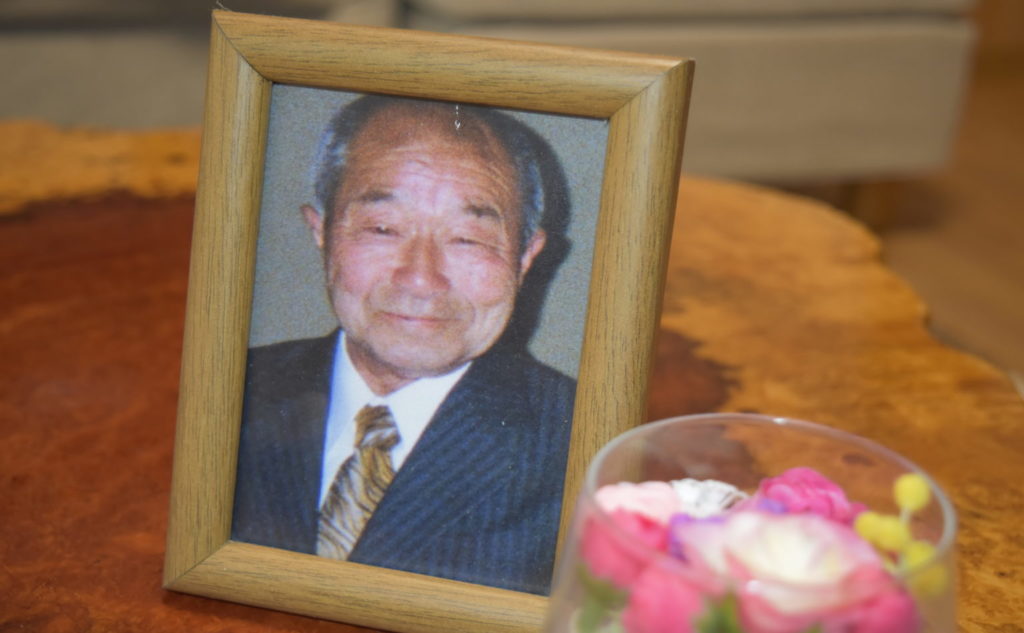
Portrait of Kenzo Kanno. Photo taken on March 5, 2021 by Nanami Nakagawa. (C) Tansa
Kanno (then 67) had run a butcher’s shop in Okuma town until the triple disaster. Immediately after the earthquake on March 11, Kanno had rushed from his shop to Futaba Hospital — only five minutes away by car — to make sure his father was ok. The receptionist had assured him that Kenzo was fine and that he had been moved to a safe location.
Relieved, Kanno returned home without seeing his father.
When the situation at Fukushima No. 1 worsened and all residents of Okuma town were ordered to evacuate in the early morning of March 12, Kanno left with his family for Tamura city, 50 kilometers to the west.
He was unable to contact Futaba Hospital from then on and, for a time, had no idea where his father had been taken.
“No one wants to take responsibility”
On March 24, Kanno was watching the news at his evacuation center, a gym in Tamura city. Glancing at the ticker at the bottom of the screen, for a second he couldn’t believe his eyes.
“Seventeen Futaba Hospital patients dead.”
Kanno had assumed that everyone had been safely evacuated — how had so many patients died?
He found a city official on duty at the evacuation center and told them his father’s name: “Please tell me where he is.”
The official soon returned and told Kanno that Kenzo had been admitted to a hospital in Fukushima city. Again, Kanno breathed a sigh of relief.
On April 5, Kanno, who by then was staying in a hotel repurposed for evacuees, received a call on his cellphone.
“Your father is a patient at our hospital.”
But the call was from a hospital in Aizuwakamatsu city — not the Fukushima hospital Kanno had been told earlier.
Still unsure how his father had ended up in Aizuwakamatsu, Kanno went to go see him the next day.
He found Kenzo bedridden and hooked up to an IV. Although conscious, he was clearly in poor health.
“He seemed confused, like he didn’t quite recognize me when I came in,” Kanno remembered.
Two months later, on June 12, Kenzo passed away.
Kanno just couldn’t understand it. Although Kenzo had spent six months in Futaba Hospital recovering from a bad case of pneumonia, he had been energetic and sharp when they last met. Kanno remembers his father confidently proclaiming that he would “still be kicking at 100.”
Driven by a need to understand what had caused this drastic change, Kanno began looking into what had happened to his father in the days after the earthquake. He discovered that Kenzo had been part of the group evacuated on March 14 — the group that had been subjected to the most grueling journey.
That day, Kenzo had been conveyed by bus for roughly 10 hours and over 230 kilometers from Futaba Hospital to Iwaki Koyo High School. After spending a night on the school’s cold gym floor, he was taken the next day to a hospital in Fukushima city, another 100-kilometer journey. That matched the information Kanno had received from the city official on March 24. But the next day, March 25, Kenzo had been transferred again to the Aizuwakamatsu hospital, 80 kilometers away.
Exhausted by the repeated journeys, he died before reaching his 100th birthday.
Kenzo had raised livestock during Kanno’s youth. As a father, he had been strict, even harsh.
Once, when Kanno was a child, Kenzo had given him a dressing-down for secretly taking out the family’s horse.
Kanno had tried to deny it, but his father overrode him with “Are you kidding — the horse is all lathered up!”
During that period, Kenzo had a tempestuous character, and Kanno often found himself the target of his father’s anger. He left home early to put some space between himself and Kenzo, joining the Self-Defense Forces and later working on a deep-water tuna fishing boat.
But even so, Kanno felt that he had been a favorite among Kenzo’s four children.
In his early 30s, Kanno quit his job on the tuna boat and opened a butcher’s shop in Okuma. Before long, his father made it a habit to pop by.
“Even when he didn’t need anything, he would often come by with a friend,” Kanno remembered, his expression nostalgic. “Now, just what was I supposed to do with them?”
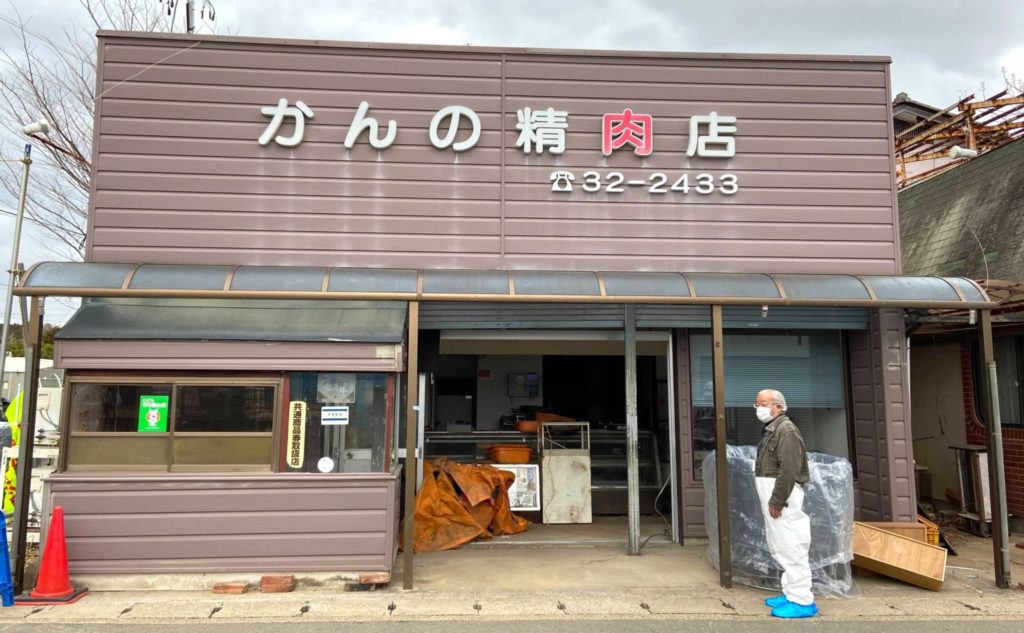
Kanno’s butcher’s shop. It lies within the zone designated “difficult to return” and has been scheduled for demolition. Photo taken on March 5, 2021 by Nanami Nakagawa. (C) Tansa
Until the Fukushima disaster occurred, Kanno hadn’t been that familiar with nuclear energy. He hadn’t know what his son-in-law, who worked at Fukushima No. 1, had meant when he said “The plant’s in bad shape; we have to vent” during a hurried visit on the night of March 11.
But following his father’s death, Kanno started learning all he could, reading academic articles and compiling clippings from newspapers.
In September 2019, the Tokyo District Court ruled that three former executives from the Tokyo Electric Power Company, which owns Fukushima No. 1, were not guilty in a case of professional negligence resulting in death regarding the deceased patients from Futaba Hospital and Deauville Futaba. Kanno had been present to hear the verdict.
“Not guilty — that’s just the way it is,” he said bitterly. “Nobody wants to take responsibility for what happened. I bet they think that, if enough time passes, we’ll just forget.”
Kanno has filed his own civil suit against TEPCO. He isn’t after the money; he feels someone needs to be held responsible for his father’s death.
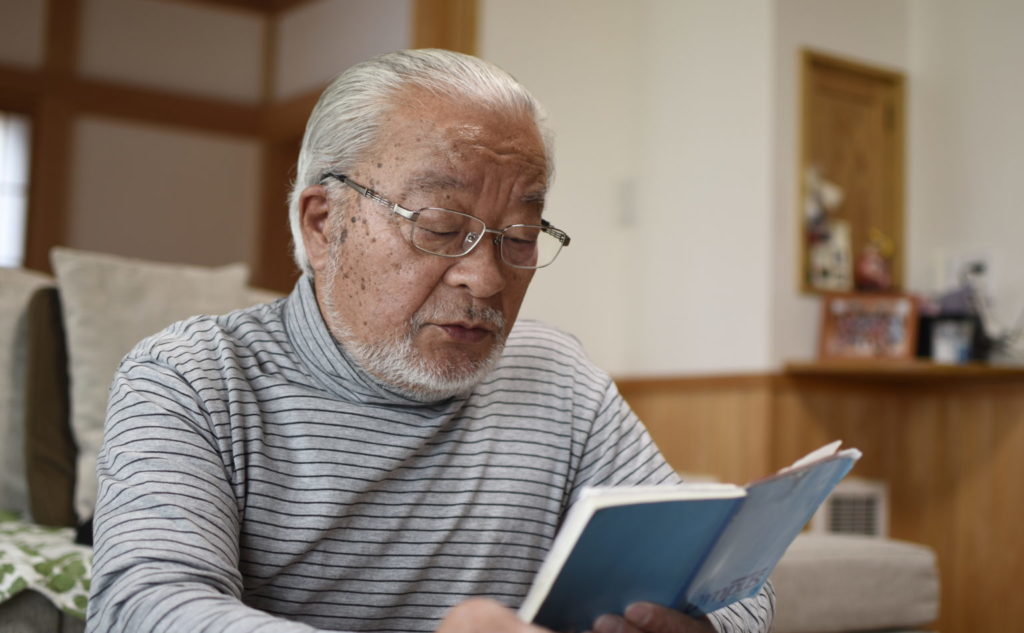
Masakatsu Kanno at his home in Mito city. Photo taken on March 5, 2021 by Nanami Nakagawa. (C) Tansa
“It’ll be as if the disaster never happened”
Masumi Kowata (57 at the time of the disaster) is another Okuma resident who questions whether those 45 deaths could have been prevented. Kowata, who ran a cram school in Okuma, evacuated to Aizuwakamatsu as her home was lost to radiation.
One day, near the end of March, she was approached by a woman at the evacuation center. “I feel so awful about it,” the woman said said, crying.
Kowata recognized her as a former student from her cram school, who had been working as a junior nurse at Futaba Hospital until the nuclear accident. Kowata remembered her as not a quick study but an extremely hard worker. They had celebrated together when she received her nursing license and found work at Futaba Hospital.
“What’s wrong?” Kowata asked.
“Not everyone made it out,” the woman explained through her tears.
She had attended the first group of patients that were evacuated on March 12; 227 were left behind that day. This was the first time Kowata was hearing about the situation at the hospital.
“It was horrible,” the woman said.
Kowata herself had worked as a nurse’s assistant at Futaba Hospital before opening her cram school. The experience gave her a personal connection to the patients’ plight, and she decided to try to figure out what had happened.
She started by asking people in the evacuation center whether they knew anything about the Futaba Hospital evacuation.
But, for some reason, no one was talking. One individual even went so far as to tell Kowata not to look into the matter.
She tried asking the SDF officers posted to the evacuation center, but none answered her questions. And when she approached an Okuma city official, he blew up at her: “How the hell would I know about that, huh?”
Another individual advised Kowata to “stop asking weird questions.”
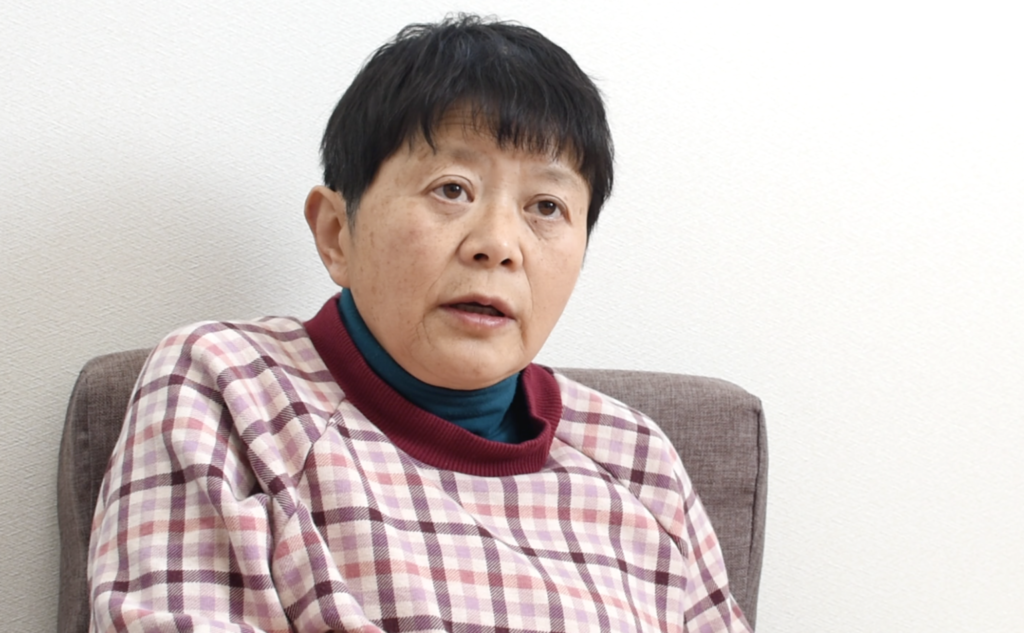
Masumi Kowata at her home in Okuma town. Photo taken on March 3, 2021 by Nanami Nakagawa. (C) Tansa
Futaba Hospital Director Ichiro Suzuki passed away in January 2019, at age 84. Kowata remembers him well: He had already been appointed director when she worked at the hospital 40 years ago.
“He was perfect for that job,” she said. “He would come up to the staff when we were hard at work and say, ‘Now, don’t forget to take a tea break, everyone.’”
And she remembers him once confiding to her that “The patients here have have nowhere else to go.”
Kowata had understood him perfectly. Many of them had no one who could — or, sometimes, who would — take them in, even if their condition improved, so they just stayed at the hospital. Suzuki never turned them out.
“Once, a wealthy family from Tokyo brought their mentally ill daughter to be hospitalized here,” Kowata recalled. “It was like Futaba Hospital was a place for those on the margins of society — the last place they had left to go.”
Kowata is currently serving her second term on the Okuma city council; the town’s remaining residents now live outside the “difficult-to-return” zone. She was first elected in 2015, and received the greatest number of votes out of all candidates during her second run in 2019.
What are the lessons of Fukushima, of Futaba Hospital? Who bears responsibility for the lives lost or forever altered? Even a decade after the disaster, these questions have been kept nebulous.
And when ordinary citizens seek answers, the government refuses to aid them in their search.
Kowata decided to run for city council with the realization that “If we don’t do something, it’ll be as if the disaster never happened.”
100 trips to the evacuation zone
Kanno and Kowata aren’t the only ones who have continued to examine what happened at Futaba Hospital.
Shinshu Hida (73), a photographer living in Miharu, Fukushima Prefecture, has been documenting the abandoned towns near Fukushima No. 1 ever since the disaster. By now, he’s taken hundreds of thousands of photos in over 100 trips into the evacuation zone. He was kind enough to allow us to use his photos in this series.
Hida first travelled to Okuma on March 18, 2012. Cows, gone feral since their masters fled, made it known that he was unwelcome in their deserted kingdom. The roads were still fissured from the quake.
When he arrived at Futaba Hospital, located five kilometers from Fukushima No. 1, Hida found wheelchairs and hospital beds lying where they had been left near the entrance. Crumpled sheets and blankets that hadn’t been touched in a year were damp from snow and rain. By the side of the road, cardboard boxes containing water bottles and biscuits had been abandoned, unopened, perhaps forgotten in the flight from radiation. Hida photographed it all.
He was also able to photograph inside the offsite center, which has since been demolished. Memos on whiteboards contained figures like “Futaba Hospital: 93 (48 remaining),” preserving a record of the evacuation as it progressed. Laptops, markers, and iodine tablets lay scattered over the tables, a vivid reminder of how quickly the offsite team decamped — without completing the Futaba Hospital evacuation — as radiation levels skyrocketed.
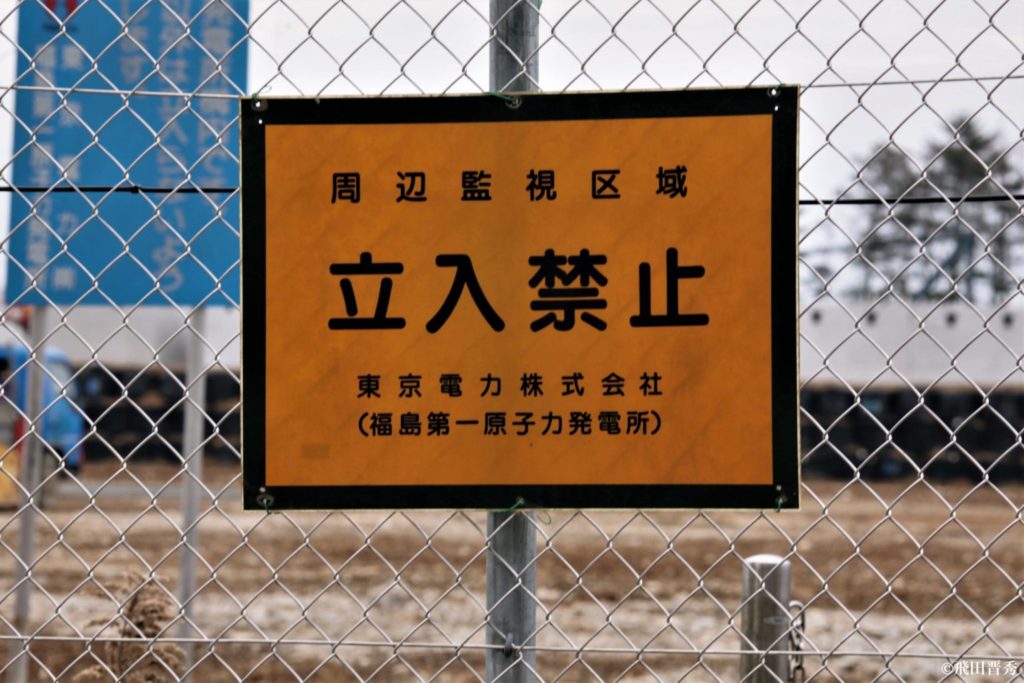
“Do not enter” sign on the fence surrounding Fukushima No. 1. Only a year after the disaster, Hida ventured close to the nuclear plant to take photographs. Photo taken on March 18, 2012 by Shinshu Hida. (C) Shinshu Hida
Although he has been warned by friends that too many trips into the evacuation zone could result in permanent health damage, Hida has kept up his work. After returning home, he carefully labels each photo.
“What good would they be if people don’t know what they’re looking at after I’m gone?” he explained.
“I especially want to show kids what happened to Fukushima because of the nuclear disaster. After all, I think they see clearer than us adults sometimes.”
97 documents
Although our story pauses here, there is still much more to learn about the mismanaged evacuation of Futaba Hospital — in particular, about the role of the SDF, which conducted four of the five rescue operations.
Through communication with the Ministry of Defense regarding our freedom of information requests, Tansa learned that the ministry possesses 97 documents relating to the Futaba Hospital evacuation. However, we were told that the disclosure of all the documents would take over a year.
But, based on past experience, requests usually take about a month to process. Why is this case different?
Tansa will continue to pursue this investigation, including through the Ministry of Defense documents and other sources. See you in part two.
(Compiled from articles originally published in Japanese on March 25 and 26, 2021. Translation by Annelise Giseburt.)
Abandoned at Futaba Hospital: All articles
 Newsletter signup
Newsletter signup